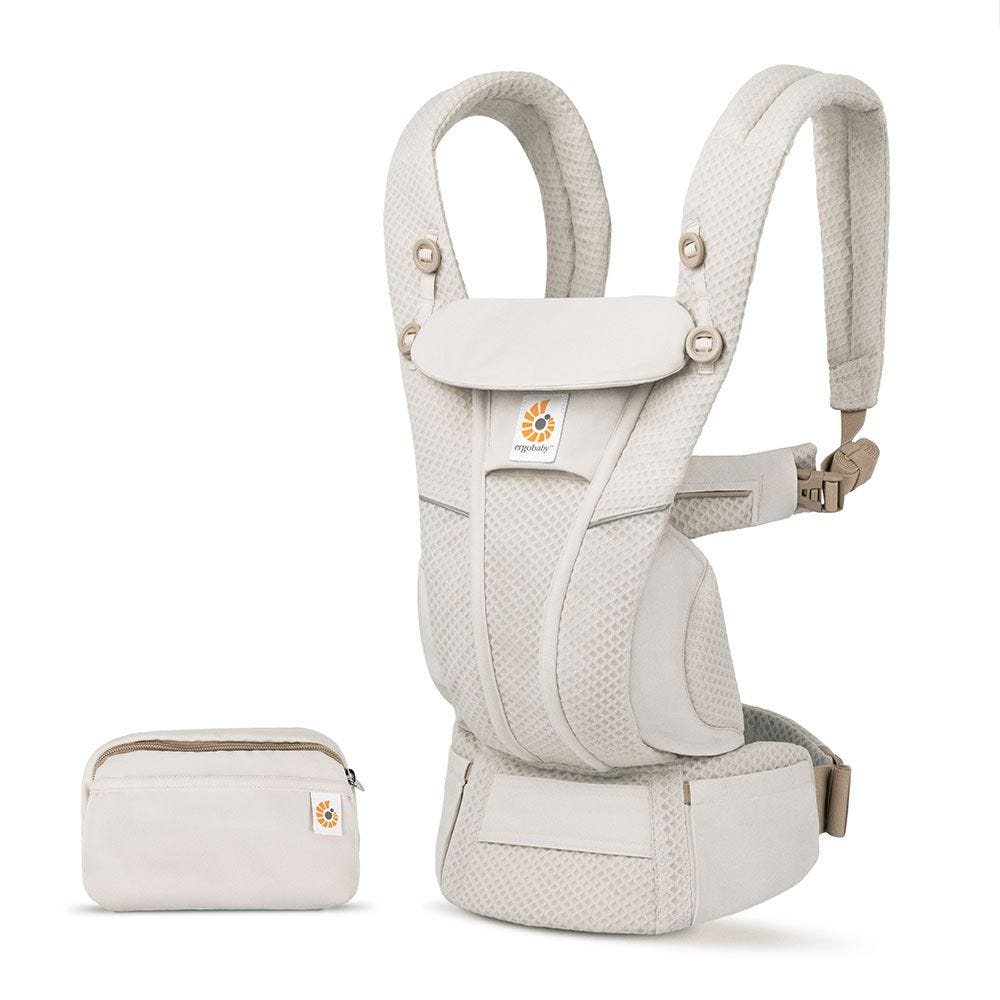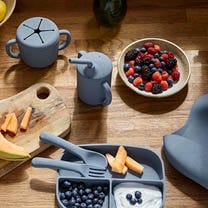Blog
April 08, 2025
What an exciting milestone in baby's development: crawling! At last they can expand their range of movement more quickly and independently. Crawling is baby's first important step towards independence. But when is it time? When do babies start crawling? And how can you as parents and carers encourage crawling? In today's blog article, we want to give you everything you need to know about the big milestone of crawling. What can you expect in the different phases? What different crawling styles are there? How can you support your baby? And when do you need to see your GP if it’s not happening?
Independence, here I come! When do babies start crawling?
On average, most babies can crawl at around nine months old. However, like with everything, every baby crawls at their own pace. Some children are ready at six months, while others may not start until nearer their first birthday. You can recognise from these early signs that your baby is starting to learn to crawl:
Getting stronger during
March 31, 2025
Be the first to test our brand NEW Metro 3 Stroller!
Packs small. Rolls big.
Want to try the newest Ergobaby stroller—for FREE?
We’re looking for five testers to experience our latest innovation: the Metro 3 All-in-One Compact Stroller—before anyone else!
SIGN UP NOW
Why test the Metro 3?
Magic One-Hand Fold: Effortless fold for easy transportation and storage —perfect for small boots, and airplane cabins.
Newborn-Ready: Integrated newborn nest and car seat compatibility.
Roomiest Seat: More space for your little one to ride in comfort.
Comfort for Everyone: Cushioned seat + adjustable handlebar for a better experience for both baby and parent.
On-the-Go Rest: Near-flat recline for instant naptime, anytime.
Covered by the ErgoPromise Lifetime Guarentee
SIGN UP NOW
What’s involved?
Receive a Metro 3 Stroller (colour assigned by default).
Test it in real-life situations for 15 days.
Share your experience and feedback on our website.
Do you have a child between 0 and 4 years old?
March 28, 2025
Strollers — every parent needs one. And convenience — every parent wants it. And with our stroller tips and hacks, you can make using your stroller more convenient and functional, as well as provide a safer and more comfortable ride for your little one.
SHOP ERGOBABY COMPACT STROLLERS
Portable Wipes Dispenser for Easy Clean-ups
Attach a compact wipes dispenser to the stroller handle using a Velcro strap. It's perfect for quick clean-ups of spills, sticky hands, or the stroller seat.
DIY Stroller Trash Bag
Turn a small, plastic-lined, reusable tote or drawstring bag into a DIY trash can by clipping it to the stroller handle with a carabiner. Ideal for wrappers, wipes, and other on-the-go messes.
Travel-Friendly Stroller Cover
Traveling with a stroller? For travel days, use a compact stroller bag to protect your stroller in the overhead bins, in car boots, or if you leave it at the bottom of the steps to go underneath the plane. It keeps the stroller clean and ready for your
March 21, 2025
“99% risk of having Down Syndrome”. That was what the report said. I’m pretty sure there were also exclamation marks at the top and I’m pretty sure they were also in red. And the word, RISK?! Yikes. I wish they would use words more like: 99% OPPORTUNITY for having Down Syndrome! No wonder the first feelings are worry and fear!
Sure, this is not what you expected. This birth and this future might not be what you had in mind. And please, moms and dads, take the time to feel that- all of it. The grief, the pain, the panic, the questions. But can I just say, as I am 2 years in, the good comes! And it comes fast! And sometimes it's coupled with struggle, but the good is bigger!
Words matter. Tone matters. The voices of the Down Syndrome Community matter and that is why I want to start by thanking Ergobaby for asking the question- what are the “Things I Wish I Knew When I Learned My Baby Had Down Syndrome”? These sorts of conversations whether they be blogs, posts, articles, podcasts were
March 18, 2025
There are so many wonderful benefits of babywearing. From supporting baby’s natural posture to reducing infant crying to strengthening the bond between baby and their caregivers and more, using a baby carrier is a win-win for you and your baby - emotionally, cognitively and physically.
But if you’ve never used a baby carrier, everything is new and unknown. So, you might be asking yourself things like what kind of ergonomic baby carrier should you use? When can you start using a baby carrier? Is a baby carrier safe for newborns? What about baby carrier safety and hip dysplasia?
Here are the basic things you need to know about using a baby carrier.
1. You can start using a baby carrier from day one.
So, let’s start with the question: is a baby carrier safe for newborns? Yes, if it offers the correct ergonomic support. With the right carrier or wrap you can even take it with you to the hospital and use it the day your baby is born. Using it in the early days and weeks is a great way to bond
March 13, 2025
Parents’ everyday routines are busy and at times chaotic. And while children are wonderful, they can also make everyday errands into an epic event. Need to run to the store just for milk and toothpaste? Alone, you can be there and back home in 10 minutes. But with a baby, you never know how long it’ll take. You have to pack a nappy bag, put your child and their stuff in the car/stroller/carrier etc. - there’s 25 minutes right there (not including any surprise setbacks like a nappy explosion just as you’re ready to go) and you haven’t even made it into the shop. It can make any sane parent feel overwhelmed.
But life requires leaving the house some days. You have places to go and people to see; not to mention your sanity to keep. Want to know what can help you keep your sanity? A lightweight compact stroller. It can’t pack a nappy bag or put your child into their car seat, but it does add some convenience to your everyday routine. What are the benefits of lightweight compact strollers?
March 06, 2025
It’s a parenting right of passage, learning how to change a newborn nappy, but when you stand at the changing table for the first time and see this delicate creature lying in front of you, you may suddenly have doubts. It’ll become second nature soon enough, after all you’re going to have plenty of practice (8-12 times a day at the beginning!). And to help you feel even more confident, we've got a few helpful tips on how to ergonomically handle your baby while changing them, that will make it more comfortable for them and you.
What do you need to change your baby properly?
While this might not seem like rocket science, no one wants to find themselves in the middle of the changing process only to realise something is missing. Walking around with your half-naked baby in your arms is asking for trouble. So, having a checklist makes sure you’ve got what you need…
1. A safe space to change baby: Your changing table or changing station should be in a quiet and warm place. Always secure your
March 02, 2025
Do you have a little love who is incredibly curious and tries to see, understand and soak up as much of the world around them as possible? Do they constantly turn their head to the side when they’re in your baby carrier because there is so much to discover? If this is the case then they may be getting ready to face forward/outward (they mean the same thing). You can try it in any carrier that ergonomically supports this position, for example our Omni Deluxe baby carrier, and provided that your little one is ready.
How do you know if they are ready? They need to have reached the right size and stage of development, which usually happens around five - six months old. You can find out what else you need to know if you want to use an forward facing baby carrier in today's blog. When to carry your baby forward facing: the right time
Carrying your baby forward or outward facing is something you likely will do intuitively even without a baby carrier. As soon as your baby is around five-six
February 26, 2025
It’s official! A 100% recommendation rate, high ratings in key areas, and the ergonomic accolade from Aktion gesunder Rücken e.V. (AGR) campaign for healthier backs! The verdict is clear: our Ergobaby Alta hip carrier and Lift hip carrier are both loved by babywearing consultants, parents, their children and by us, of course. They are also the only baby hip carriers on the market designated “back friendly” by the experts at the AGR. But what else makes our hip seats so special and why are Lift and Alta recommended as baby hip seats by so many different experts?
The advantages of the Alta hip carrier and Lift hip carrier
If you have an active baby or toddler you will be familiar with being asked to pick them up then put them down then pick them up and so on and so on. The result: back pain, tired arms or other postural problems. If you keep lifting your little one up and sit them on your hip (without a designated hip seat), this takes its toll on your body: your spine is no longer in
February 20, 2025
There comes a time when your little love starts to feel heavy being carried on your front, even with the most ergonomic baby carrier around! And it can get tricky to see around them or bend down with them on your front. But you love exploring the world with them and you don’t want that to end. The good news is that it doesn’t have to. Because you can carry your baby on your back. And for quite a while yet. And we’ve got a whole bunch of reasons why we think you’ll both love an Ergobaby back carry, and exactly how to do it in a baby carrier like our Omni Deluxe. Because the end of babywearing is only in sight when the weight limit of your baby carrier is reached (20.4 kg for the Omni Deluxe) or when either of you no longer want to do it.
Requirements for carrying your baby on your back
To be able to carry your baby safely on your back, they should be able to:
demonstrate strong head and neck control
sit unassisted
weigh 17.2 lbs/7.8 kg
All babies are different but most will reach these



















